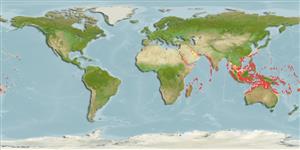>
Eupercaria/misc (Various families in series Eupercaria) >
Labridae (Wrasses) > Cheilininae
Etymology: Oxycheilinus: Greek, oxys = sharp + Greek, cheilos = lip.
More on author: Lacepède.
Environment: milieu / climate zone / depth range / distribution range
Écologie
marin; saumâtre récifal; profondeur 3 - 60 m (Ref. 90102). Tropical; 30°N - 23°S
Indo-Pacific: Red Sea and East Africa to the Marshall Islands and Samoa.
Taille / Poids / Âge
Maturity: Lm ? range ? - ? cm
Max length : 40.0 cm SL mâle / non sexé; (Ref. 9823)
Épines dorsales (Total) : 9; Rayons mous dorsaux (Total) : 10; Épines anales: 3; Rayons mous anaux: 8 - 11. Differs from the very similar C. unifasciatus by always lacking the white bar in front of the caudal base as well as the area clear of red streaks extending from the eye to just above the pectoral axis (Ref. 1602).
Found solitary (Ref. 90102) in lagoon and sheltered seaward reefs in coral rich areas (Ref. 1602, 58652). Possibly to 120 m depths. Young is more inshore on sheltered reef crests or slopes, usually amongst soft corals or stinging hydrozoans (Ref. 48635). Feeds on hard-shelled mollusks, crustaceans, and sea urchins (Ref. 27550). The species is observed to swim with a group of goatfish and change its color to resemble these fish, it then darts out from the group to catch small fish (Ref. 2334). This species curiously approaches divers closely (Ref. 90102).
Life cycle and mating behavior
Maturité | Reproduction | Frai | Œufs | Fécondité | Larves
Oviparous, distinct pairing during breeding (Ref. 205).
Randall, J.E., G.R. Allen and R.C. Steene, 1990. Fishes of the Great Barrier Reef and Coral Sea. University of Hawaii Press, Honolulu, Hawaii. 506 p. (Ref. 2334)
Statut dans la liste rouge de l'IUCN (Ref. 130435: Version 2024-1)
Menace pour l'homme
Harmless
Utilisations par l'homme
Pêcheries: intérêt commercial mineur; Aquarium: Commercial
Outils
Articles particuliers
Télécharger en XML
Sources Internet
Estimates based on models
Preferred temperature (Ref.
123201): 25.4 - 29.1, mean 28 °C (based on 910 cells).
Phylogenetic diversity index (Ref.
82804): PD
50 = 0.5020 [Uniqueness, from 0.5 = low to 2.0 = high].
Bayesian length-weight: a=0.01905 (0.01008 - 0.03600), b=2.95 (2.78 - 3.12), in cm total length, based on LWR estimates for this species & (Sub)family-body (Ref.
93245).
Niveau trophique (Ref.
69278): 3.7 ±0.4 se; based on diet studies.
Résilience (Ref.
120179): Faible, temps minimum de doublement de population : 4,5 à 14 années (Preliminary K or Fecundity.).
Fishing Vulnerability (Ref.
59153): Moderate vulnerability (39 of 100).
Nutrients (Ref.
124155): Calcium = 43.1 [16.4, 95.4] mg/100g; Iron = 0.639 [0.238, 1.421] mg/100g; Protein = 18.9 [16.0, 21.0] %; Omega3 = 0.149 [0.079, 0.287] g/100g; Selenium = 31.8 [12.1, 90.4] μg/100g; VitaminA = 105 [30, 407] μg/100g; Zinc = 2.03 [0.91, 3.46] mg/100g (wet weight); based on
nutrient studies.
